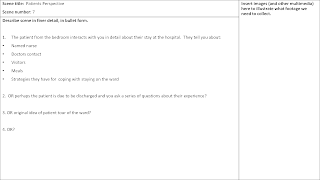Back in April 2022, our head and my line manager, Dr Anne Felton, and I started to explore opportunities in nursing virtual placements. We intended to conduct a short pilot to try out the process and explore the possibilities to showcase for the wider department. With a long-term view of building a catalogue of different virtual placement offerings. Anne defines virtual placements as;
"Virtual placements would involve developing practice scenarios that the students might work through online. These can be used to compliment practice placements for example to support an induction through a virtual tour, a patients view of the ward or to create some practice-based scenarios to get them to think and reflect, for example on how they might respond in certain situations, what might the implications be etc. There are many possibilities for them but my initial target is to help students make up practice hours."
Ideally we wanted our first virtual placement to be live for September, for the start of the next academic year. The pilot was approved and kicked off with a planning workshop, held on the afternoon of 13th April 2022. A mix of students, service users and academics were invited to form a working group. I designed and led the workshop (and overall project), and Anne assisted in facilitating the discussions. I took a brief rapid learning design approach as shown in the slides below. Followed by further slides where I curated the outputs of the day, for the group to access and review.
Before we headed into the main planning aspects, Anne introduced the outline for the afternoon, defined what we mean by virtual placements for the pilot needs/context and group introductions. I then showcased some curated internal and external examples using potential digital technologies. Namely H5P - Virtual Tour (360) and Branching Scenario, ThingLink and PebblePad, to stimulate ideas, possibilities and discussion to flow into the afternoon.
Post-planning workshop, myself and Anne agreed to use the internal NTU tool, H5P, to create a virtual 360° tour - using the Virtual Tour (360) content type. The external tool ThingLink was a contender, but I was keen to use what we had already access to (approved and supported), I'm an expert in and that can achieve the same outcome. And also supports the long-term vision of creating a catalogue of virtual placement options. We will look to creating video-based scenarios further down the line, e.g. using H5P's Branching Scenario content type.
The next stage was to asynchronously flesh out our identified 'Introduction to a ward' scenes by developing a storyboard. I placed the process instructions in the Microsoft PowerPoint, where I facilitated and prompted as we progressed through it. I chose PowerPoint as hopefully the wider group have used this previously. But if individuals found the process and tool difficult navigate, I invited them to reach out personally to go through it with them. The plan after that was to asynchronously review and reality check the storyboard. Then I suggested we meet synchronously online to check in with each other, if the group are available. During this time, we would also look to assigning roles of who can support with the production, e.g. capturing footage. I tried to arrange a synchronous meeting but the group's availability made asynchronous more feasible to facilitate. Below is the storyboard template I put together that includes the identified ward scene with some group contributions.
Anne - "Thanks very much for pulling all this together Dan. I’m looking forward to developing the specifics!"
So after we have confirmed the storyboard content, I needed to start planning how we would capture the actual footage to support the virtual placement activity. As most of the group have access to the appropriate content locations. I needed a couple of volunteers to help capture the required imagery and supply other pieces of content and props detailed in the storyboard, so that I can produce in H5P. I invited them to contact me so that I can coordinate with them on using our 360° camera and agree timescales.
As availability was becoming more precious, and as the project timescales are flexible, we decided to scale back the pilot 'Introduction to a ward' scene. To focus only on a the notice board present in that particular scene - isolating an individual interactive element. An academic is now in the process of creating this and should be ready by December. I'll update below as this progresses.
On a related topic - earlier in November 2022 in the central Association for Learning Technology mailing list, Karoline Nanfeldt posted a the query; "Virtual nursing placements - I’d love to hear experiences/good practice anyone has had delivering virtual placements, in particular for nursing or other health care related fields."
There was a few responses, including one with a really useful paper - so I responded with:
"Many thanks for asking this and for the contributions that followed, especially yours Tim which I will take the time to read through. [Tim Cappelli, Orchestrating Technology to Create Integrated Learning Experiences for Nursing Students, 8th e-Learning Excellence Awards 2022 - An Anthology of Case Histories - see Orchestrating Technology to Create Integrated Learning Experiences for Nursing Students]















